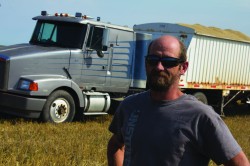News | August 23rd, 2017

Photo by Sabrina Hornung
Photo Slug: Dennis Neustel in his field near Robinson ND
The month of May usually ushers rains that nourish the land. This year, however, the spring showers did not come and drought gripped most of North Dakota, parching the landscape. The western half of the state has it the worst, with once lush pastures and fields sprouting feeble plants and tawny dust.
“All the [weather] models had spring rains and then the day before we were expecting to see some rains materialize, they just disappeared or showed up over Minnesota,” said Allen Schlag, hydrologist with the National Weather Service in Bismarck. “Meteorologically, I do not know that there was a large driving factor behind it. To a certain extent, there is a little bit of luck that has to play in it.”
Droughts reap through North Dakota in cycles, almost once a decade. But May turned out to be the fourth driest month in over a century, Schlag said. As farms and ranches grappled with the arid reality, Governor Doug Burgum declared a state of emergency that lifted restrictions and fees on trucks schlepping hay and livestock.
“North Dakota is probably the worst,” said Dr. Charlie Stoltenow, assistant director at North Dakota State University Extension Service. “It is the center of the drought,” that blankets the Midwest.
In mid-August, as some 99.6 percent of North Dakota moiled in drought, according to the U.S. Drought Monitor, Burgum requested a presidential major disaster declaration that would unleash direct federal assistance.
Meanwhile, the state ramped up its own efforts to help the sector. The Water Commission approved a $825,000 emergency project to pour water to livestock producers through new wells and pipelines. It might take quite some time to get water to some ranchers, though, said North Dakota Agriculture Commissioner Doug Goehring.
“All of our well drillers, as I understand, are currently pretty busy,” said Goehring. “So, some of those people are going to be on the wait list for quite a long time, but at least, in the future, they will have a well in some very remote locations or where they had nothing before.”
This year, as water and feed run low, many ranchers have already parted with some of their cattle. One of them is Dennis Neustel, who owns a farm near Robinson, where the drought is rather moderate.
“I sold older cows early,” he said. “I would have kept them a couple of more years but the grass is short, so you have to get rid of the ones that are not as good just to keep the better around, so that you got something.”
But the price was not favorable, making it arduous to get even, Neustel said. Not to mention that as ranchers pare down their herds, their source of future wealth thins out.
The dearth of good pastures and hay to sustain cattle have had some ranchers turn to wheat, too weak to make it on the market. They harvested it early and bailed it for feed. This, however, comes with a caveat. In dry conditions, nitrates tend to accumulate in grains to levels that can poison cows. Nitrate toxicity tests might be vital in shunning the risk.
And yet, hay remains the feed of choice for many. To cope with the lack of it, the Department of Agriculture and NDSU have set up a donation-based hay lottery program. It all started with Ag Community Relief, a Michigan organization, that sought to contribute hay to drought-stricken North Dakota but floundered how to transport it to individual ranchers.
“Once we started hearing from producers about how severe the drought was, we knew we had to help in some way,” said Matt Schaller, president of Ag Community Relief, in a statement.
Once the hay arrives in Fargo, the winners will be drawn in early September.
Apart from the lottery, NDSU FeedList serves as a connection between ranchers in need and those in a position to help. An online forum that began two decades ago, the register bustle with submissions.
In July, a farmer from Strasburg, N.D., seeking hay, wrote, “We are in an extreme drought – not enough hay, no corn.” Another, based in Clinton, Minnesota, offered to winter calves early.
“Historically, our winter calves are weaned off and sent to Nebraska, South Dakota or Iowa,” said Dr. Stoltenow. “That is going to move up this year. That is how we try to manage our resources – if we can decrease the amount of nutrient requirements on those mama cows, then they eat less, so we have to haul less hay.”
When it comes to hauling, Farm Rescue, a volunteer-based nonprofit in Horace, N.D., recently launched its Operation Hay Lift.
“Depending on the size of [ranchers’] operation, how many livestock or cattle they have, we will determine how many free loads we haul, or if it’s multiple hauls we will do for just fuel reimbursement,” said Bill Gross.
He founded Farm Rescue a little over a decade ago to assist farmers and ranchers, who have suffered a major injury, illness or natural disaster. This year, the latter is proving to be the most prominent hurdle, Gross said.
If ranchers are toiling to shield their livestock from the drought, crop producers do not have it any better. Although the region had fair subsoil moisture to nurture crops, the scarcity of spring rains hampered their development. Wheat suffered badly. Usually yielding 35 to 40 bushels per acre, this year, fields are expected to bear only five to 10, North Dakota Wheat Commission reported.
“For some producers it’s the worst crop in many years,” said James Peterson, marketing director of North Dakota Wheat Commission.
Because of the drought in the Northern Plains, in August, the United States Department of Agriculture lowered its wheat production estimate by 21 million bushels, to under 2 billion. The average national price amounts to $4.80 per bushel, dragged down by increased global production. Because of the low returns, some farmers in North Dakota have switched to soybeans and canola, said Peterson.
Although early August saw rain, it aids soybeans but not wheat. Not all is lost, though. Hard red spring wheat, whose high protein content is favored by bakers, and durum wheat, used for pasta, are to fetch good prices, said Dr. Stoltenow, and bring in revenue for some.
This will not help Neustel, the farmer from Robinson. After borrowing money to buy land and equipment almost two decades ago, he said he might have to take a loan early next year.
“Well-established farmers that have had land for generations, they probably have profit every year,” he said. “Years like this are probably hard on them, but they probably got some money in a bank to help them through. But for the guy who is a first or second-generation farmer, it is really hard to get by. This year will show no profit, definitely going backwards.”
With a tightened bi-annual budget, North Dakota does not have an emergency fund to provide a financial cushion for drought-affected farmers and ranchers. The Bank of North Dakota, however, is considering disaster-type loans, said Goehring.
Together with the National Weather Service and USDA’s Risk Management Agency, he is also devising a rainfall index program, a type of insurance policy that would reimburse North Dakota’s farmers for precipitation shortages. Splitting the state into 12–by–12–mile grids, where coverage is divided into two-month intervals that collate current to historic rainfall percentages, the concept is being upgraded for data accuracy.
Although the rainfall index is a system in the works, nowadays farmers and ranchers benefit from robust federal protections that have evolved since 1983, which brought one of the harshest droughts in the U.S. There is crop insurance and livestock indemnity and price loss coverage and marketing assistance loans, among others.
“We are a lot better financially in terms of protections that we were years ago,” said Dr. Michael Rosmann, agricultural behavioral health expert, educator and columnist. “Now that doesn't mean that farmers and ranchers do not worry, because we always worry -– that is just our nature, to worry about [whether] we are going to have enough rain, and are the prices going to be adequate to make some money.”
Concern is inherent in what Dr. Rosmann calls the agrarian imperative, the unrelenting impetus to produce food and fiber for millions. When farmers’ efforts do not pay off, psychological stress might afflict them. “We [farmers] are sometime hard on ourselves,” Dr. Rosmann said. Yet he acknowledged an emotional resilience that has strengthened from a generation ago.
Neustel seems to confirm Dr. Rosmann’s observation. Talking about today’s predicaments, he often uttered his hope for a better 2018.
Nonetheless, only time can tell. If this winter and next spring turn dry, subsoil moisture will virtually vanish. “We really are going to be in trouble then,” said Dr. Stoltenow of NDSU.
The economy of North Dakota, where agriculture is the largest industry, is already hurting. Low commodity prices and poor yields are not solely dinting farmers’ bottom lines but also those of businesses that either rely on or service agricultural producers. With agriculture boasting the highest multiplier effect in the state, “the problem is the money doesn’t go into the economy and flow through it,” said Goehring.
Hardship, nonetheless, often renders a silver lining. For Dr. Stoltenow, the drought has once again shown the communal fortitude of farmers and ranchers across the country.
“In times like these, I really appreciate working in agriculture because I get a call from an agent from Wisconsin who says, "I have a producer in Wisconsin who wants to send 100 hay bales to North Dakota. How we do that?" It is gratifying to work in an industry, where people care about each other and they help each other.”
July 7th 2025
June 9th 2025
April 30th 2025
April 24th 2025
April 23rd 2025
__293px-wide.jpg)




__293px-wide.jpg)